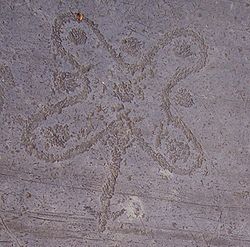Val Camonica
Val Camonica or Valcamonica or Valle Camonica is a valley in northern part of Italy. Valle Camonica is also a UNESCO heritage site.
Cities
[edit]
The main towns are:
Other destinations
[edit]Understand
[edit]Valle Camonica (or also Valcamonica and, in the Camunian dialects, Al Camònega, poetic Camunia) is one of the largest valleys in the central Alps, in eastern Lombardy, about 90 km long.
It starts from Passo del Tonale, at 1,883 m a.s.l. and ends at Corna Trentapassi near Pisogne, on Lake Iseo. It has an area of approximately 1335 km² and 120,000 inhabitants (2017). It is crossed in all its length by the high course of the Oglio river, which originates in Ponte di Legno and has its mouth in the Sebino between Pisogne and Costa Volpino.
Valle Camonica's name is derived from the term in Latin language with which the classical writers in ancient times called the population who lived there: the Camuni.
Climate
[edit]The climate varies a lot according to the area and the altitude at which you are. The climate also depends a lot on areas exposed to winds or prolonged shading, so as to mark significant climatic changes between nearby, but sunny and sheltered locations.
Snow rarely falls in the valley, but it is abundant, especially during the winter season, on mountain peaks and in ski resorts.
Get in
[edit]By plane
[edit]The nearest airport is:
- Bergamo-Orio al Serio international airport, Via Aeroporto 13, Orio al Serio, ☏ +39 035-326323.
By train
[edit]You can reach the valley by train from Brescia. Timetables and fares are available on Trenord website.
Get around
[edit]You can use cars, buses or catch Trains
See
[edit]
- Rock Drawings (UNESCO site), in Capo di Ponte and Darfo Boario Terme.
Do
[edit]Eat
[edit]Those offered by local trattorias and restaurants are ancient flavours; simple and genuine culinary elaborations that draw on tradition.

Among the first courses the inevitable "casoncelli", ravioli stuffed with meat and vegetables and other ingredients that vary from country to country, tagliatelle, maltagliati, sometimes with chestnut flour, gnocchi, barley soups and tripe.
Among the meats, the "Brenese sirloin", donkey stew, mutton sausage, salted meat, sausages called "strinù" and pure pork cured meats. There is no shortage of rabbits, poultry and game, hares and wild boars.
In addition to meat, lake river fish, sometimes dried according to traditional methods. Corn or buckwheat polenta is the perfect side dish for many main courses.
The breeding of cattle, goats and sheep guarantees the production of excellent cheeses. The variety is truly surprising: formelle, "silter", "casolet", ricotta, "fatulì", "bagoss" and goats, natural or flavoured with herbs.
In the area of Lake Sebino, at an ideal altitude, an oil with important characteristics is produced.
To appreciate the different types of bread, white or rye, and the desserts, simple and genuine; “Spongade”, biscuits and cakes with chestnut flour.
There is no shortage of IGT wines, liqueurs and grappas, classic or flavoured with berries, berries, alpine herbs or honey.
Drink
[edit]The flavours of the Camonica Valley and the Brescia side of Lake Sebino belong to the tradition of mountain and water life; hence a legacy of aromas, colours and tastes that give life to an essential cuisine but rich in history and secrets to be discovered. The natural beauties ranging from the rugged snow-capped mountains to the sweetest slopes, enlivened by the slow flow of rivers, up to the silence and light of the lakes create a unique relationship between man and nature, and the cuisine of the territory is the concrete and solid expression of people of these places. Each season brings with it the products of its land and the diversity of this natural territory offers the opportunity to fully enjoy the strong and straightforward flavors marked by the passage of time.


 Français
Français Italiano
Italiano




